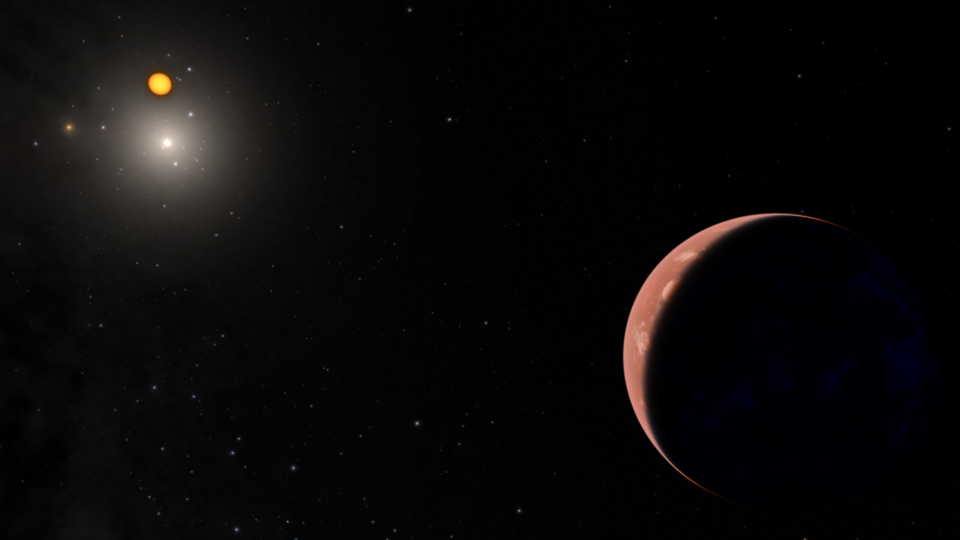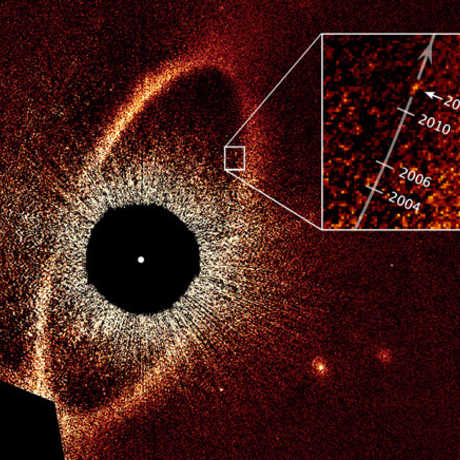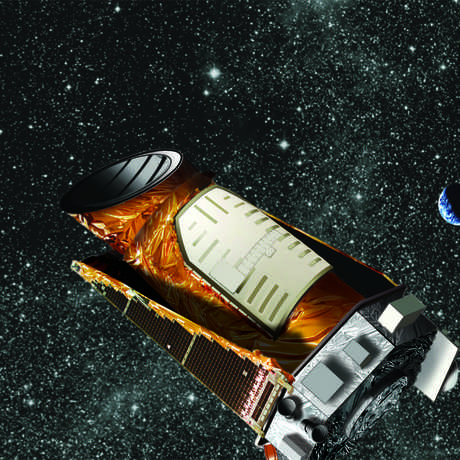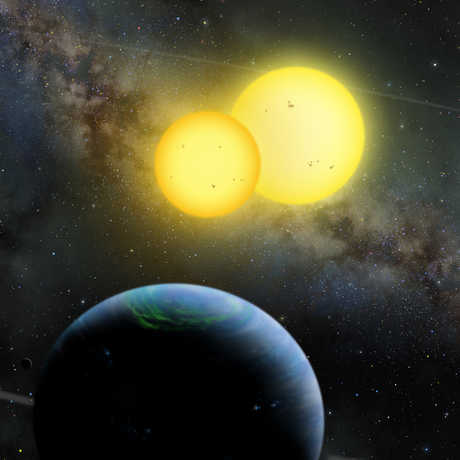Science News
A Close, Habitable Exoplanet and a Dark Matter Galaxy

Rosetta Observes Comet Outburst
On February 19 of this year, the Rosetta mission made an unprecedented observation of an outburst from Comet 67P/Churyumov-Gerasimenko that, according to European Space Agency (ESA) press release and an upcoming publication in Monthly Notices of the Royal Astronomical Society, was triggered by a landslide on the comet’s surface.
In what was described as a “happy coincidence” by ESA’s Matt Taylor, nine of Rosetta’s instruments, from cameras to dust collectors to gas and plasma analysers, were all pointing at 67P at the same time in a pre-planned coordination when the unexpected event occurred, allowing for the simultaneous gathering of the “most complete set of data on an outburst ever collected.”
Some of that data included a strong brightening of the comet’s coma, a 30°C (nearly 90°F) rise in the surrounding gas, a sixfold increase in dust emission, and a significant jump in both plasma and gas output. And while the event occurred six months ago, and the data was sent to Earth within just a few days, scientists have been analyzing the data to reconstruct a clear chain of events.
The landslide occurred in the Atum region of the larger of 67P’s two lobes (the “body” of the “rubber duck”). That region was just rotating out from shadow when the event occurred, so it’s likely that thermal stress on the surface weakened the area, triggering the slide that exposed water ice to the Sun’s light. This exposure caused the ice to turn to gas immediately, taking surrounding dust with it to form the debris cloud detected by the OSIRIS camera.
“As a result, we think the outburst must have been triggered by a landslide at the surface, rather than a more focused jet bringing fresh material up from within the interior.”Examples of outbursts caused by the latter explanation include this one from last year.
Soon, Rosetta will get a much closer look at the comet, as it is scheduled to end its mission September 30 with an attempted landing near its long separated lander, Philae, which bounced precariously to the comet’s surface in November 2014. The end of the mission, of course, will not mean an end to research. As this six-month delay between observation and publication demonstrates, there is still plenty of data collected by Rosetta for scientist to pore over and publish on for years to come. –Elise Ricard
The Closest Exoplanet of All
In a press conference and paper published in Nature on Wednesday, a team of astronomers announced the existence of a planet orbiting the star Proxima Centauri in the constellation Centaurus the Centaur. The discovery was made by the European Southern Observatory (ESO)as part of a multinational collaboration called “Pale Red Dot”—an homage to Carl Sagan’s 1994 description of Earth seen from a distance as a “Pale Blue Dot.” The project was a search for planets orbiting Proxima Centauri, a cool, red star (hence the twist on Sagan's poetic catchphrase).
By detecting a regular wobbling of the star caused by the gravitational pull of an orbiting body (the “radial velocity” method), the astronomers inferred that the planet, dubbed “Proxima b,” has at least 1.3 times the mass of Earth. It circles Proxima once every 11.2 days at a distance about one-twentieth Earth’s distance from the Sun. That may seem awfully close, but since Proxima is smaller and fainter than the Sun, its habitable zone lies closer to the star than the one that Earth is comfortably nestled within. This zone represents the range of distances where the temperature would allow liquid water to exist on an Earth-like body, and in this case, it envelops at least a portion of Proxima b’s orbit. How fully the planet’s orbit is within the zone will be determined by further observations.
Why is this a big deal, and what’s one more exoplanet, compared to the more than 3,000 already confirmed? Proxima is part of the Alpha Centauri system, and if that name still doesn’t ring a bell, it’s the nearest star system to the Sun, meaning that there’s an exoplanet right next door—ignoring for a moment that “next door” is 40 trillion kilometers (25 trillion miles) away. The system consists of a close binary of Sun-like stars, Alpha Centauri A and B. These are orbited very distantly by Proxima (sometimes called Alpha Centauri C), which is presently the closest of the three to the Sun, at a shade less than 4.3 light years. It will continue to be closest for about the next 25,000 years, until its half-million year long orbit takes it farther away than the binary pair). Except possible “rogue” objects flung out of their own solar systems and wandering through interstellar space, there can’t be anything closer—but the closest-known rogue is about 100 light years away.
However, other than the lower limit of its mass and the basic parameters of its orbit, there’s still a lot we don’t know about Proxima b itself. We do know that its immediate neighborhood presents a few challenges. Its star, Proxima, is what's known as a flare star, which occasionally undergoes dramatic, wildly unpredictable outbursts of both visible light and more energetic, non-visible forms of electromagnetic radiation. For example, the ESO study indicates that Proxima b is occasionally exposed to hundreds of times the x-rays that Earth receives from the Sun. What’s unknown is whether the planet has an atmosphere that might shield it to some degree from such radiation or whether it has a magnetic field that might also help mitigate the effects of tidal locking, which is expected for a planet so close to its star. Tidal locking keeps the same side of the planet facing Proxima in the same way the maria-blotched near side of the Moon always faces Earth. The effect that tidal locking might have on the planet’s atmosphere and on the chances for habitability on its surface, is a topic for debate.
Being the closest exoplanet to the Sun, Proxima b is sure to be the subject of close scrutiny from observatories both on the ground and orbiting Earth, including the venerable Hubble Space Telescope and its soon-to-be-launched successor, the James Webb Space Telescope. Already, Proxima b has attracted the immediate interest of the Breakthrough Starshot project, which Colin Elliott wrote about in April. Breakthrough Starshot aims over the next few decades to design a futuristic nano-technology mission that will send several small, lightweight vehicles to the Alpha Centauri system at one-fifth the speed of light, reaching its destination in 20 years… now with a tweak in its trajectory that passes a “Pale Red Dot.” –Bing Quock
A Dark Matter Galaxy
Deep in the Coma Cluster of galaxies, astronomers have uncovered a strangely dim galaxy that is thought to be made almost entirely of mysterious dark matter.
This type of dim and diffuse galaxy has been seen before, but since such objects are challenging to image, they have not been studied extensively. While the galaxy was first imaged by the novel Dragonfly Telephoto Array (giving the galaxy its name, “Dragonfly 44”), the powerful Keck telescopes have allowed astronomers to uncover the high level of dark matter composition by measuring the motion of stars moving within the galaxy.
The speed of the stars can tell astronomers a great deal about the mass of their galaxy. Stars in a small galaxy typically move slowly—if a star travels too quickly, it would be flung clear of the galaxy. More massive galaxies can keep hold of faster stars. However, inside Dragonfly 44—a galaxy with very few visible stars—the stars move with tremendous speed. How is this meager galaxy able to hold itself together? With invisible (or dark) matter.
In order for stars in Dragonfly 44 to be able to move as fast as they do, the galaxy itself must be 99.99 percent dark matter, since dark matter outweighs visible (sometimes called baryonic or luminous) matter by 10,000 to one.
These ultra diffuse galaxies (called UDG’s by the researchers) have often been thought of as failed galaxies, but now it seems that they represent a new type—one overwhelmingly dominated by dark matter. The cause of a dark matter dominated galaxy is still unknown, but a structure like this could allow for more direct attempts at observation and, maybe one day, a better understanding of this mysterious substance which has so profoundly shaped our Universe. –Josh Roberts


